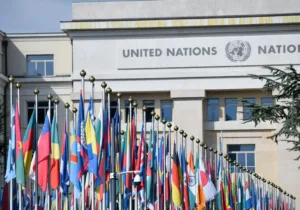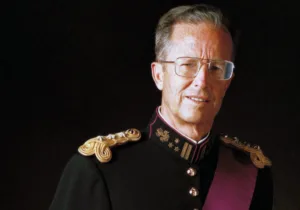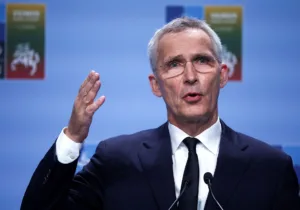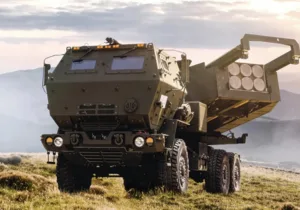Foreign ministers from NATO members are gathering in Washington this week to mark the military alliance’s seventieth anniversary. Here’s what you should know about one of the oldest and most successful defense pacts in history.
1. The foundations of the North Atlantic Treaty Organization (NATO) were officially laid down on April 4, 1949, with the signing of the North Atlantic Treaty, also known as the Washington Treaty. The Treaty derives its authority from Article 51 of the United Nations Charter, which reaffirms the inherent right of independent states to individual or collective defense.
2. NATO’s creation was part of a broad effort to serve three purposes: deterring Soviet expansionism, forbidding the revival of nationalist militarism in Europe through a strong North American presence on the continent, and encouraging European political integration.
3. Collective defense is at the heart of the Treaty and is enshrined in Article 5:
The Parties agree that an armed attack against one or more of them in Europe or North America shall be considered an attack against them all and consequently they agree that, if such an armed attack occurs, each of them, in exercise of the right of individual or collective self-defence recognised by Article 51 of the Charter of the United Nations, will assist the Party or Parties so attacked by taking forthwith, individually and in concert with the other Parties, such action as it deems necessary, including the use of armed force, to restore and maintain the security of the North Atlantic area.
Any such armed attack and all measures taken as a result thereof shall immediately be reported to the Security Council. Such measures shall be terminated when the Security Council has taken the measures necessary to restore and maintain international peace and security.
Since 1949, Article 5 has been invoked once—in response to the 9/11 terrorist attacks in the United States in 2001.
4. NATO’s stated purpose is to guarantee the freedom and security of its members through political and military means. Using political means, NATO “promotes democratic values” and enables members to “consult and cooperate on defense and security-related issues” to solve problems, build trust, and prevent conflict.
Using military means, NATO is committed to using “military power to undertake crisis-management operations” if diplomatic efforts fail to reach a peaceful resolution. Military operations can be carried out under the authority of Article 5, under a United Nations mandate, or alone or in cooperation with other countries and international organizations.
5. In 1949, 10 European countries joined the US and Canada in signing the North Atlantic Treaty. Currently, there are 29 members of NATO: Albania (2009), Belgium (1949), Bulgaria (2004), Canada (1949), Croatia (2009), Czech Republic (1999), Denmark (1949), Estonia (2004), France (1949), Germany (1955), Greece (1952), Hungary (1999), Iceland (1949), Italy (1949), Latvia (2004), Lithuania (2004), Luxembourg (1949), Montenegro (2017), Netherlands (1949), Norway (1949), Poland (1999), Portugal (1949), Romania (2004), Slovakia (2004), Slovenia (2004), Spain (1982), Turkey (1952), the United Kingdom (1949), and the United States (1949).
6. NATO membership is open to “any other European state in a position to further the principles of this Treaty and to contribute to the security of the North Atlantic area.” NATO also has what it calls the Membership Action Plan (MAP). MAP provides advice, assistance, and practical support for aspiring member countries. Current participants in MAP are Bosnia and Herzegovina and the Republic of North Macedonia.
7. NATO has very few permanent forces of its own. Once members agree, by consensus, to engage in an operation, they contribute forces on a voluntary basis.
NATO has an integrated military command structure, allowing the alliance to implement political decisions that have military implications. Approximately 20,000 military personnel are engaged in NATO operations and missions around the world.
8. NATO is currently engaged in several ongoing military operations and missions, including Resolute Support Mission (RSM), Afghanistan; Kosovo Force (KFOR); Operation Sea Guardian in the Mediterranean; assistance to the African Union; and military headquarters in Bosnia and Herzegovina and in the former Yugoslav Republic of Macedonia. Additionally, the alliance conducts civil emergency operations on an as-needed basis. For example, the alliance is assisting with the ongoing response to the refugee and migrant crisis in Europe.
9. NATO has two official languages: English and French. That’s why in North America, the North Atlantic Treaty Organization is most commonly known by the acronym NATO. But in Europe it more frequently referred to as OTAN, which is French for Organisation du Traité de l’Atlantique Nord.
10. NATO has two sources of funding, direct and indirect. The largest type is indirect contributions, which come, for instance, when a member nation volunteers equipment or troops to a military operation and pays the cost out of its own national budget. Direct contributions are made to finance requirements of the alliance that serve the interests of all members. According to NATO, costs are borne collectively, often using the principle of common funding. Within the principle of common funding, all 29 members contribute according to an agreed cost-share formula, based on Gross National Income, which represents a small percentage of each member’s defense budget. NATO’s civil budget provides funds for personnel expenses, operating costs, and capital and program expenditure of the international staff at NATO Headquarters. NATO’s military budget covers the operating and maintenance costs of the NATO Command Structure. For 2019, the civil budget is $281.7 million (€250.5 million), and the military budget is $1.6 billion (€1.395 billion).
Joe Carter is an adjunct professor of journalism at Patrick Henry College, an editor for several organizations, and the author of the NIV Lifehacks Bible.
Photo Credit: US Secretary of State Mike Pompeo with the other NATO ministers of foreign affairs and NATO Secretary General Jens Stoltenberg. NATO photo, via Flickr.







 Live in the DC area? Sign-up for Providence's in-person events list!
Live in the DC area? Sign-up for Providence's in-person events list!